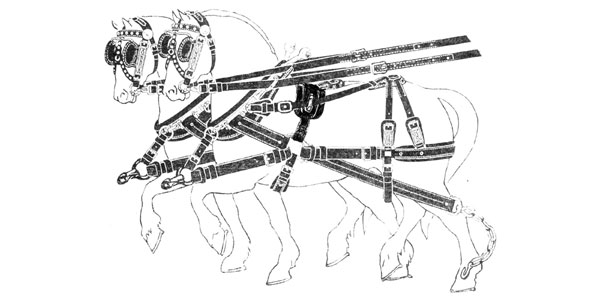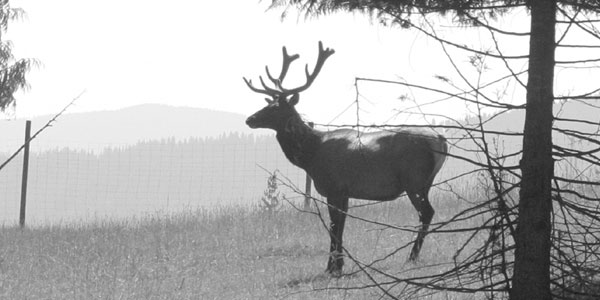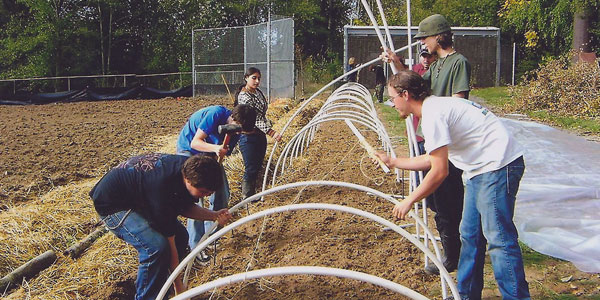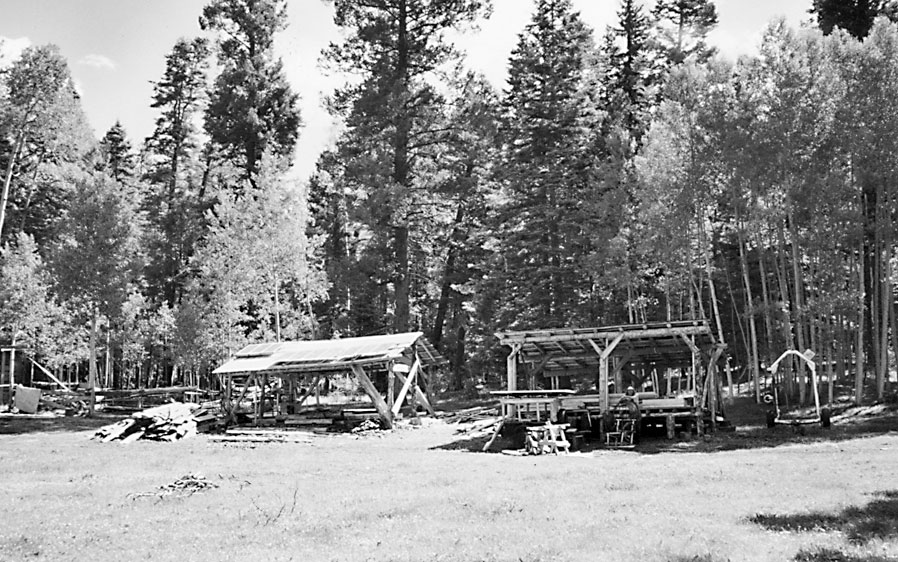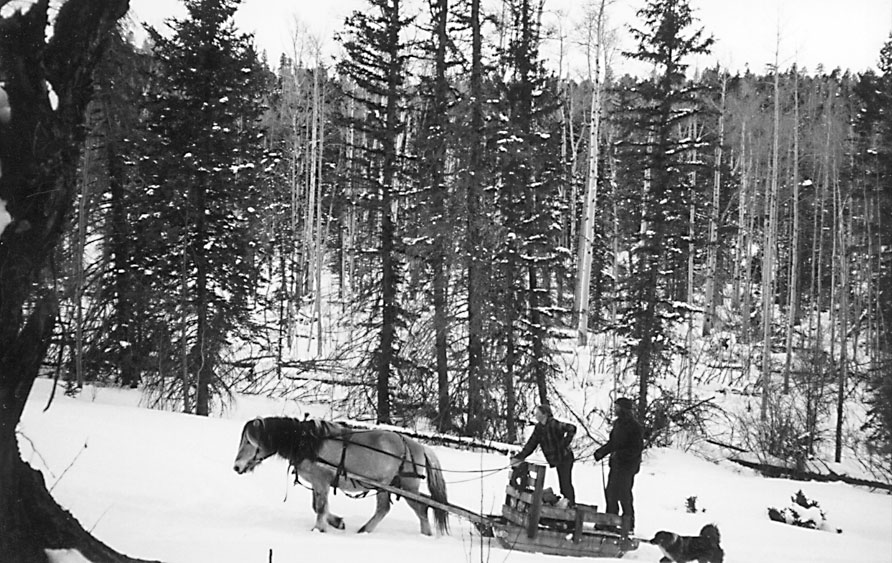
The Cutting Edge
The Cutting Edge
by Mary Steigerwald of Ojo Sarco, NM
Horses, Solar Powered Saws and Independence
I guess it all started the day I looked out the cabin window as my husband Rico passed by, bent over and straining as he dragged a sled full of heavy firewood through the deep snow: while plodding behind him came the two saddle horses we were boarding, looking mildly interested. “Wait a minute!” I remember chuckling to myself, “What is wrong with this picture?” It suddenly occurred to me that, given the conditions of our life here at 9400 feet in Northern New Mexico – snowed-in four months of the year, cutting and hauling timber, building our log cabin, breaking sod – what we needed was a draft horse or two. Our experience with horses was limited and to learn all there was to learn seemed to be a formidable task: yet it was easy to imagine how wonderful it would be.
That was five years ago. Little did I know, as I daydreamed that morning, what was in store for us here in our wilderness home we call Edge Habitat.
Shortly thereafter, in the spring of ’97, Rico, our daughter Aspen and I, spent one long night trying to get some sleep as the fifty-year-old cabin shook and the wind roared and shrieked deafeningly through the forest around us. In the morning we awoke to a three quarters of a mile long swath of old growth mixed conifer and aspen trees, uprooted and strewn everywhere we looked. We wandered around that morning in a daze as the reality of what had happened during the night sank in.
We hadn’t moved here to become loggers, but it looked like God had other plans! We had chosen to become caretakers of this beautiful place because of the peace and quiet, the clean air, the myriad of birds and wildlife! We wanted to create a mountain retreat! To conduct a typical logging operation, we felt, would completely ruin all that made this place so special. Thus, we were presented with a challenge: how to clean up this blowdown in a clean, sustainable way.
With the help of our solar gizmologist partner, Brad, we bought a Norwood portable bandsaw mill and after enduring the gas powered motor long enough to “learn the ropes,” we knew we had to convert to an electric motor to be run on solar power, as soon as possible.
If this had ever been done before, we were not aware of it. Brad set to work designing the system. After the gas motor was removed, an old 36 volt Cushman golf cart motor from a golf cart repair shop slipped right into place! He wired it to six golf cart batteries, bolted a 36 volt solar panel array to the mill shed roof and it worked perfectly! The mill was clean and quiet and it put out beautiful boards and beams, with a little help from the sun.
Inspired by our success, we turned our attention to the chainsaws. We knew electric chainsaws could be run on solar power, but we wondered if they had enough power to cut big logs, and the thought of using a long cord in the tangled mess of the blowdown was unnerving. But we knew we had to give it a try. Brad put together a portable solar power system, we bought a Stihl E220 electric chainsaw and the results were amazing. The saw has plenty of power. The cord is not a problem because the whole scene is more relaxed without the noise and stress of the gas saw and the user tends to move more slowly. As one onlooker commented, “It’s more like a sewing bee than a logging operation!” Rico finds the electric saw is much easier on his hands, which are damaged by years of gas chainsaw use, and of course he loves not having the noise and toxic exhaust right in his face for hours on end. Best of all, the power comes from the sun!
The next logical step in our sustainable logging operation was – a draft horse! The ad in the paper said “Norwegian Fjords, gentle, strong and unflappable.” We went to the breeders and there was Ingot, a three-year-old gelding with a strong, compact body, stout legs like pillars and about as calm a disposition as any horse could have. The breeders offered to send him to the trainer and allowed us to make payments. One month later, Ingot was here! He settled into his life here in Fjord horse heaven, let his mane grow out, and became a member of the family.
So then we had the horse but not the know-how. That’s when a friend told us about Small Farmer’s Journal. We immediately sent for the Workhorse Handbook and Training Workhorses, Training Teamsters. We read these books over and over, cover to cover, absorbing all we could of Lynn Miller’s wisdom. The books gave us the confidence to start ground driving Ingot, who already knew what to do, by running long lines through his tied-up saddle stirrups.
Lynn often stresses the value of finding somebody who’s already working with draft horses, to learn the hands-on stuff that books can’t quite convey. So, we were thrilled to hear about a weekend draft horse workshop being held in a town not too far from home. We spent two long days watching and participating as a couple of western movie stunt men – the guys who really drive the runaway stage coaches – took us through the whole process, from harnessing to hitching to driving. It was a crash course but combined with all of our studying, it gave Rico the confidence to give Ingot a try. He built a wooden stoneboat, hitched-up Ingot, gave a cluck and it’s been smooth sailing ever since. Ingot is amazingly calm, trusting and nearly fearless. He will pull anything we hitch him to, without blinders and without hesitation. Ingot pulls logs from the blowdown and pulls the mobile solar power sled that Rico built – a wooden sled with a pair of old skis mounted to the bottom – to wherever it is needed. He gives us sled rides in the snow and hauls our firewood and supplies.

Thirteen year old Aspen drives Ingot while Rico practices his ballet. The cabin in the background is 50 years old.
Over the six years we’ve lived here in the mountains we’ve had to contrive to earn a living at home. We keep things simple and do a lot of trading. Plus, local folks have been very generous – our old friend Fidel, for instance, who with a tear in his eye presented Rico with a beautiful collar and harness, left over from his days long ago, working mules in the woods. “When I’m gone, my kids won’t know what to do with this stuff,” he said. But we do need cash and our animals are helping with that, too. Each year, we expand our garlic and potato fields, thanks to Ingot with his harrow and plow. Our little pinto pony, Amy Goodman, is ready to pull a little manure cart. Along with their saddle horse mascot, Calypso, and the three llamas, they provide entertainment and pack support for visitors to our camp and guide retreat.
We’re looking for another Fjord like Ingot to help him pull our big wagon and bigger sled loads, and we look forward to becoming less dependent on the gas-powered truck as we use the animals more and more.
We find that people are really drawn to our little scene. While many are impressed by the high-tech solar equipment, it is the horses at work, the organic farming, the simplicity and the natural lifestyle that speak the loudest and many a visitor has been inspired to reminisce about days gone by. Farm draft horses are no longer common in our local communities, having only recently been replaced by tractors and trucks, or more likely, abandoned as the farmers themselves have disappeared. Not long ago, horse drawn wagons on dirt roads were a common sight, now supplanted by the asphalt, the automobile and the insidious desire to go faster.
We love the slow pace, the gentle strength, the warmth and breath and playful antics of our beloved horses. They’ve contributed to our lives and to the lives of those who’ve watched them work in ways that run deep, answering a longing for a time when life was more simple, folks moved more slowly, and a day spent at home on the farm held endless possibilities for work and creativity.
Our horse story began with a dream and simply flows from there on good intention, a sure sign that we’re on the right track. We hope it will inspire others to follow their dreams, grow some food, live more in harmony with nature, simplify their lives, spend more time at home and – consider the possibilities of the horse!
We highly recommend that anyone who must use a chainsaw consider the option of switching to an electric chainsaw and, ideally, alternative power. The detestable task of running a chainsaw becomes almost pleasant once the noise, fumes and stress are eliminated. Short of using hand tools, or rigging some sort of horse or water powered device, this is the quietest and cleanest method that’s currently possible to cut timber.
Any stoneboat, sled, wagon or cart can become a portable power source. It can be pulled up to a stationary array of solar panels to be charged, and parked next to the house or shop to supply extra power when it’s not being used in the field.
To run the electric chainsaw with solar power requires a simple system of components that are readily available and easily assembled. A new system would look something like this:
| Stihl E220 115v ac 15a | $525 |
| 2 BP-585 PV modules, 170w at 12v, $480ea | $960 |
| Trace DR-2412 inverter, 2000w or comparable | $1400 |
| 2 Exide GC-4 golf cart batteries, $80ea | $160 |
| 2 fuse block and misc | $100 |
| PV mounting rack | $85 |
| Charge controller | $75 |
| $3305 |
This system uses two solar panels, which provide three to four hours of saw running time per day. Using one panel would provide one to two hours per day. Between cuts, the electric chainsaw is not running.
This may seem expensive, but considering the absence of fuel costs over time, the benefits to the sawer’s health, the fact that the system can be used to power the home, shop or other tools at remote sites, and perhaps most importantly, considering global climate change and the current worldwide political unrest, acquiring a cleaner, more independent power source is one of the best investments you can make.

